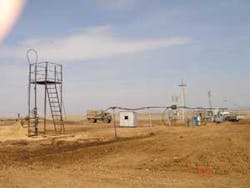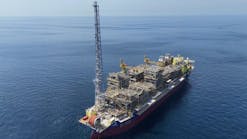Downhole cable heats high viscosity, high-paraffin oil
Several fields in Russia have installed a downhole cable that heats high viscosity and high-paraffin crude, according to Nefteservis-NN LLC.
Nefteservis-NN developed and sells the cable and associated equipment. Development of the well heating unit, called Fontan, started 5 years ago.
Benefits
Nefteservis-NN says the cable heats fluid flowing in the tubing to a temperature exceeding the wax dropout point. Some benefits of the system include:
- Ensures walls inside the wellbore, x-mas tree, and adjacent flowlines remain clean at all times.
- Prevents hydrate, asphaltine, and paraffin buildup.
- Increases well production rate, especially for high-viscosity crude oil.
- Improves electric submersible pump (ESP) performance and service life, because of a lower fluid viscosity.
- Reduces well downtime by increasing time between well repairs.
- Eliminates the use of other paraffin removal methods.
- Liquefies hydrate accumulations in gas wells.
- Heats water wells located in permafrost regions.
- Heats pipelines.
The company says operators can adjust the unit for the best temperature and power-saving operations, as well as for intermittent use.
Installations
Companies in Russia that have installed the cable include RN-Stavropolneftegas LLC (Rosneft), NGDU Buguruslanneft (TNK-BP), Lukoil JSC, TPP Lukoil-Usinskneftegas, TPP Lukoil-Ukhtaneftegas, TPP Lukoil-Severneftegas, NGDU Nurlatneft (Tatneft JSC), Naryanmarneftegas LLC, NGDU Talakanneft (Surgutneftegas JSC), Kyrgyzneftegas JSC (Kirgisia), and Kazmunaineftegas JSC (Kazakhstan).
Operators have placed the heating cable inside or outside of tubing and inside hollow sucker rods. In these wells, the cable is within the interval of wax crystallization.
Nefteservis-NN says production in wells equipped with the cable increased from 10-30% and uptime of wells with ESPs has increased to 700 or more days from 365 days.
It estimates that for wells producing 150-220 bo/d with continuous operation of the cable at 50 kw, the unit will pay out in about 60 days.
The heating system includes the cable in the well and associated control equipment (Fig. 1; photo from Nefteservis-NN).
The standard set of equipment for the unit includes heating cable, control desk with spare parts, wellhead packer, connection terminal, wellhead wired temperature gauge, flash memory (MMS-card), and software. Fig. 1 shows one installation on a well in Russia.
Additional equipment includes wellhead running in hole and pulling out of hole device, step-up transformer (if cable length is greater than 1,150 m), and drawworks.
Fig. 2 shows workers installing the cable.
The automatic controls allow for:
- Switching on and off the cable heating.
- Controlling cable voltage and load current.
- Controlling temperature change.
- Decreasing heat when pump unit is off.
- Protecting the cable from short circuits.
- Switching on after power interruption or when temperature drops below the wax crystallization point.
- Monitoring operation parameters.
- Recording operations.
- Data transmission for remote monitoring and control from a distant control room or personal computer. The sites in Russia use wire-linked modems or cellular communication with GSM-modems.
The cable except for the load-bearing wireline has armored polymeric skin. For lengths greater than 2,000 m, the cable has a central load-bearing wireline (Figs. 3 and 4).
The cable either has a flat or round shape (Fig. 4; photo from Nefteservis-NN).
To obtain greater cable reliability, Nefteservis-NN connects the heating conductors to various poles of a feed supply by dividing them into groups through isolating wire bundles.
Nefteservis-NN says that since 2004 no well equipment with the cable has ceased production or needed repair because of wax accumulation.
Pilot tests
Nefteservis-NN ran pilot tests on the cable technology in wells in Kharyaga field, in the Timan Pechora province of Russia.
In Well 1126, it installed the cable at 1,479 m in May 2004. In the previous year, 2003, the company said the well had experienced eight stuck scrapers prior to running in hole with a gamma-ray tool, two workovers for removing hydrate-wax deposits, and seven jobs/month for reaming out tubing to about 1,400 m. The reaming jobs tagged wax at 200-400 m and 700-900 m.
The operator also treated the well continuously with a dewaxing unit 14-16 times/day to a 1,000-m depth. In 2003, the well had 52 hot-oil treatments, which involved 19 flowline flushing jobs and 33 jobs on the ESP. The average flushing volume was 9 cu m/job for the flowline and 30 cu m/job for the ESP and required 1.5 hr/job for the flowline and 4.5 hr/job for the well.
In 2003, the well’s hot-oil treatments consumed 1,100 cu m of oil.
Nefteservis-NN says before running in hole with the gamma ray, the well produced at 42 cu m/day with a 1% water cut. With the cable installed, the average surface temperature was 43° C. with a cable temperature of 69° C., and the well increased production to 50-55 cu m/day.
The 1,525-m long cable was in service 677 days during the 730 days in which the well was in operation, according to Nefteservis-NN.
In Well JVg 4089, Nefteservis-NN ran the cable to 1,605 m in September 2004.
Initial production from the well started in June 2003. Before running in hole with a gamma ray, the well during 6 months in 2003 experienced 11 stuck scrapers, 2 workover operations for removing hydrate-wax deposit, and a daily reaming of the tubing string to 1,400 m, according to Nefteservis-NN. Wax deposits were at 700-1,350 m.
The operator also treated the well with a dewaxing unit 14-16 times/day to a 1,000 m depth, and in 2003 the well had 29 hot-oil treatments on the flowline and ESP.
Nefteservis-NN says before running the gamma ray, the well produced 45 cu m/day of oil with a 1% water cut and increased to 55 cu m/day after cable installation.
The cable was in service for 902 days during which the well operated for 1,013 days, according to Nefteservis-NN.
Other installations
Nefteservis-NN says that it has installed the heat-tracing cable systems in 32 wells in Kharyaga field, 10 wells in Vozey field, and 6 wells in Kyrtaelskoye field.
On wells with sucker-rod pumps experiencing wax accumulation, it says average overhaul life has increased to 355 days from 82 days and hot-oil washings have decreased to 0.1 from 8.2 operations/year. Also average production rate increase for the 85 wells was 9.8 cu m/day, while water cut decreased in most wells with a high water cut, according to Nefteservis-NN.
It notes that in Lukoil-Usinsk Khariaginskoe oil field, the wells producing with the service life of wells ESP have increased to more than 900 days.
At Buguruslan-Oil’s Rodnikovskoe oil field, the field has experienced no production stops because of wax accumualtion since installation of the cable in December 2005, the company says.
One recent installation of the cable is in Well 1109 of Granichnoye oil field. The well produced intermittently a sucker-rod pump because the crude had a viscosity greater than 20,000 cp, according to Nefteservis-NN.
After the operator installed the cable heating unit in the casing annulus in October 2008, Nefteservis-NN notes that the pump worked continuously with a higher surface temperature of 15° C. and reduced crude viscosity to 5,258 cp. Current production is 2 cu m/day with a cable temperature of 86° C., Nefteservis-NN says.




